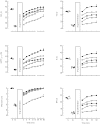Clinical and functional responses to salbutamol inhaled via different devices in asthmatic patients with induced bronchoconstriction
- PMID: 15521899
- PMCID: PMC1884617
- DOI: 10.1111/j.1365-2125.2004.02185.x
Clinical and functional responses to salbutamol inhaled via different devices in asthmatic patients with induced bronchoconstriction
Abstract
Aims: This study aimed at evaluating changes in airway patency, lung volumes and perception of breathing discomfort intensity following salbutamol administration via the Diskus dry-powder inhaler (DPI) or a pressurized metered-dose inhaler with the Volumatic valved holding chamber (pMDI + Volumatic) in asthmatic patients with methacholine-induced bronchoconstriction.
Methods: On six different study days, 18 patients inhaled methacholine until forced expiratory volume in 1 s (FEV(1)) decreased by approximately 35% of baseline. Following placebo, 200 and 400 microg of salbutamol through the pMDI + Volumatic or the Diskus, changes in FEV(1), volume-adjusted mean forced expiratory flow from 25 to 75% of the forced vital capacity (isoFEF(25-75)), lung volumes and breathing discomfort intensity, assessed by visual analogue scale (VAS) score, were repeatedly measured over a 60-min observation period.
Results: Induced bronchoconstriction was accompanied by obvious reductions in lung volumes and increases in VAS score. After salbutamol administration, FEV(1) and VAS score changes were similar in all experimental conditions. However, following 400 microg salbutamol via pMDI + Volumatic, isoFEF(25-75) values increased up to 4.48 l s(-1) (95% confidence interval 4.06, 4.90), a significantly (P < 0.01) higher value than those attained in all other experimental conditions. Independently of the salbutamol dose, lung volumes rose to significantly (P < 0.01) higher levels in pMDI + Volumatic than in Diskus trials. The low salbutamol dose via the pMDI + Volumatic and the high dose via the DPI increased isoFEF(25-75) and lung volumes to similar extents.
Conclusions: Salbutamol via the pMDI + Volumatic provides greater isoFEF(25-75) and lung volume increases in asthmatic patients with induced bronchoconstriction; salbutamol-induced changes in VAS scores poorly reflect those in small airway patency. The lack of differences in FEV(1) increases observed after 200 and 400 microg salbutamol may reflect attainment of the flat portion of the dose-response curve using either device.
Figures

Similar articles
-
Speed of onset of bronchodilator response to salbutamol inhaled via different devices in asthmatics: a bioassay based on functional antagonism.Br J Clin Pharmacol. 2006 Oct;62(4):403-11. doi: 10.1111/j.1365-2125.2006.02641.x. Br J Clin Pharmacol. 2006. PMID: 16995861 Free PMC article. Clinical Trial.
-
Agreement between two methods for assessing bioequivalence of inhaled salbutamol.Pulm Pharmacol Ther. 2008;21(2):380-4. doi: 10.1016/j.pupt.2007.10.001. Epub 2007 Oct 11. Pulm Pharmacol Ther. 2008. PMID: 17997115 Clinical Trial.
-
The protective effect of salbutamol inhaled using different devices on methacholine bronchoconstriction.Chest. 2000 May;117(5):1319-23. doi: 10.1378/chest.117.5.1319. Chest. 2000. PMID: 10807817 Clinical Trial.
-
Novolizer: a multidose dry powder inhaler.Drugs. 2003;63(22):2437-45; discussion 2447-8. doi: 10.2165/00003495-200363220-00010. Drugs. 2003. PMID: 14609355 Review.
-
Pharmacokinetics, pharmacodynamics, and clinical efficacy of albuterol RespiClick(™) dry-powder inhaler in the treatment of asthma.Expert Opin Drug Metab Toxicol. 2016 Sep;12(9):1109-19. doi: 10.1080/17425255.2016.1209485. Epub 2016 Jul 28. Expert Opin Drug Metab Toxicol. 2016. PMID: 27424535 Review.
Cited by
-
The challenge of delivering therapeutic aerosols to asthma patients.ISRN Allergy. 2013 Aug 5;2013:102418. doi: 10.1155/2013/102418. eCollection 2013. ISRN Allergy. 2013. PMID: 23984095 Free PMC article.
-
Inspiratory Profiles Through Easyhaler Dry Powder Inhaler During Acute Bronchoconstriction.J Aerosol Med Pulm Drug Deliv. 2025 Apr;38(2):83-89. doi: 10.1089/jamp.2024.0045. Epub 2025 Feb 7. J Aerosol Med Pulm Drug Deliv. 2025. PMID: 39916536
-
Speed of onset of bronchodilator response to salbutamol inhaled via different devices in asthmatics: a bioassay based on functional antagonism.Br J Clin Pharmacol. 2006 Oct;62(4):403-11. doi: 10.1111/j.1365-2125.2006.02641.x. Br J Clin Pharmacol. 2006. PMID: 16995861 Free PMC article. Clinical Trial.
References
-
- Bethesda National Institute of Health, National Heart, Lung and Blood Institute; 2002. Global Initiative for Asthma. Global Strategy for Asthma Management and Prevention. NHLBI/WHO Workshop Report 1995. Publication No. 02–3659, revised.
-
- Anderson PJ. Delivery options and devices for aerosolized therapeutics. Chest. 2001;120:89s–93s. - PubMed
-
- Newman SP, Newhouse MT. Effect of add-on devices for aerosol drug delivery: deposition studies and clinical aspects. J Aerosol Med. 1996;9:55–70. - PubMed
-
- Fontana GA, Lavorini F, Chiostri M, et al. Large and small airway responses to procaterol hydrochloride administered through different extension devices in asthmatic patients. J Aerosol Med. 1999;12:177–85. - PubMed
-
- Nana A, Youngchaiyud P, Maranetra N, et al. β2 agonists administered by a dry-powder inhaler can be used in acute asthma. Respir Med. 1998;92:167–72. - PubMed

